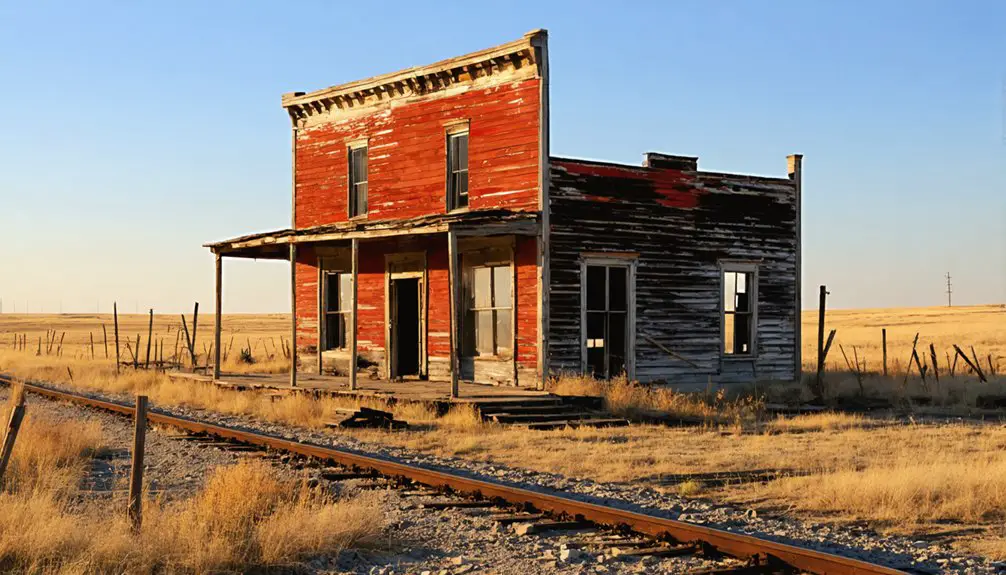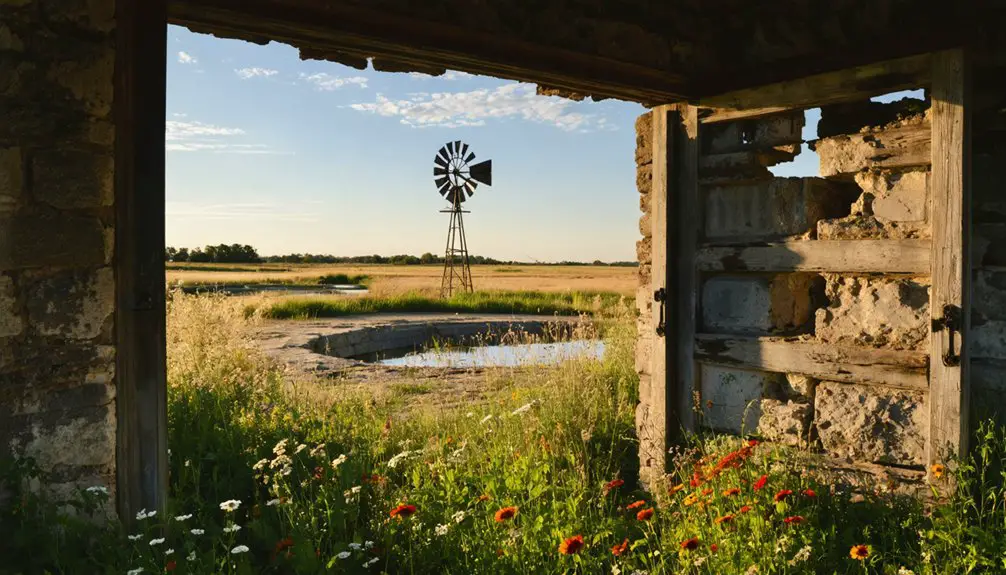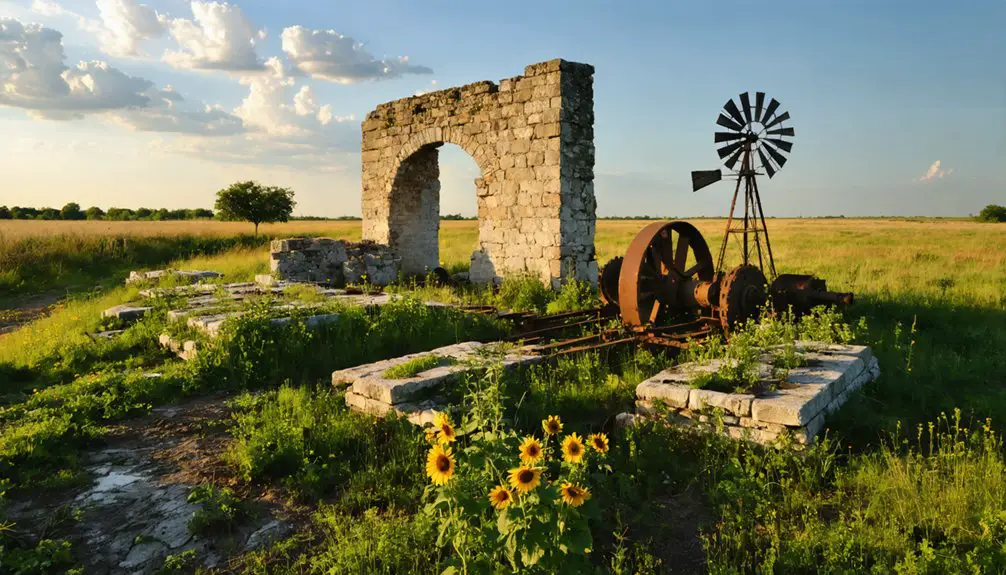You’ll find the remnants of Spring Lake and Artesian City in Meade County, Kansas, where these twin settlements emerged in 1885. The discovery of artesian wells sparked their founding, with Spring Lake established first and Artesian City following two years later. While once-thriving communities centered around flowing wells that produced over 7,110 acre-feet annually by 1939, today only scattered foundations remain on private property. The towns’ decline tells a broader story of groundwater depletion and rural transformation in Western Kansas.
Key Takeaways
- Spring Lake and Artesian City were established in 1885-1887 as dual settlements in Meade County, Kansas, driven by railroad expansion hopes.
- The towns thrived initially due to abundant artesian wells, with the first flowing well discovered in 1886 on B.F. Cox’s farm.
- Economic decline began due to over-extraction of groundwater resources and lack of promised railroad connections through northern Meade County.
- Today, only foundations remain of both towns, with most structures gone and former streets reverting to grassland on private property.
- The towns’ demise exemplifies how water resource depletion and transportation isolation can lead to community abandonment in rural Kansas.
Early Settlement and Founding Years
As settlers pushed into the Kansas frontier during the late 19th century, Spring Lake emerged as a hopeful settlement in Meade County.
You’ll find that early development began when Spring Lake was established in 1885, marking the start of ambitious plans for the region’s growth.
Two years later, developers laid out the neighboring town of Artesian, creating a dual-settlement pattern that characterized many frontier communities.
Frontier settlements often emerged in pairs, with neighboring towns competing for residents and resources in the untamed Kansas landscape.
The Missouri Pacific Railway‘s proposed route through northern Meade County sparked dreams of prosperity, leading townsite companies to organize and establish essential services.
A post office, initially placed in Spring Lake and later moved to Artesian, served as a lifeline for settlers.
The Spring Lake Town Company was officially chartered on July 6, 1885, setting the foundation for the community’s development.
However, like many Kansas settlements of this era, these towns existed largely in promoters’ visions rather than sustainable reality.
Like Spring Lake’s New Jersey counterpart established in 1875 by rail extension, the Kansas settlement hoped transportation would fuel its economic growth.
The Power of Artesian Wells
While early settlers faced numerous challenges in Meade County, they discovered an essential resource beneath their feet: artesian water. By 1939, these natural fountains produced over 7,110 acre-feet annually through springs and wells, supporting critical activities throughout the region.
The area’s first flowing artesian well appeared in 1886 on B.F. Cox’s farm, marking the beginning of widespread well development. Though spring flows decreased by more than 50% over time, the total discharge remained stable thanks to well pumping that compensated for these losses.
The water served multiple purposes – from domestic use to irrigation – with about 25% of flowing wells supporting farms and households. Despite limited groundwater management regulations, the system maintained its pressure head, proving the resilience of this underground resource that helped shape the area’s development. The water quality typically showed very hard calcium content with high iron levels, similar to other groundwater sources in Kansas.
Daily Life in the Twin Towns
Life in the twin towns revolved around a vibrant mix of structured social gatherings and public services. You’d find local governance shaping daily routines through strict ordinances, from dress codes to Sunday behavior restrictions.
The town hall hosted lively dances where Bill Long’s music and Fred Judd’s calling brought the community together.
Community gatherings flourished at social hubs like the general store, blacksmith shop, and hotel. You’d see the Board of Health maintaining sanitation standards while electric street lights replaced oil lamps in 1892. Residents had access to artesian water wells discovered in 1887, providing a reliable water source at just 142 feet deep. Similar to the healing waters at Waconda Springs, these wells attracted visitors seeking therapeutic benefits.
Local tradespeople, from blacksmiths to hotel managers, kept the economy moving. The Presbyterian Church, established in 1853, anchored religious and educational life.
Despite regulations controlling everything from stray animals to garbage disposal, these twin towns maintained a distinct character through their blend of commerce, faith, and social activities.
Economic Growth and Commerce
The economic landscape of Spring Lake and Artesian City stretched far beyond their vibrant social gatherings, with the towns’ prosperity deeply rooted in Western Kansas’ late 19th-century development.
Spring Lake and Artesian City’s economic success emerged from Western Kansas’ 19th-century growth, extending well beyond their social foundations.
You’d have seen the transformation driven by railroad expansion, which connected these communities to essential markets and spurred real estate booms throughout the region.
Agricultural trends shaped the towns’ commerce, following patterns similar to nearby Garden City’s successful sugar beet industry. Fur trading posts had previously dominated the area’s economy before farming took hold.
You could’ve witnessed how government subsidies bolstered farming operations, while crop experimentation at the Garden City Experiment Station supported sustainable practices.
The towns’ strategic position in the regional trade network linked local producers to urban markets like Kansas City, while diverse workforce contributions, including Mexican immigrant labor, kept the agricultural economy running.
Multiple rail lines enhanced market access, though economic stability often hinged on crop diversification and the establishment of innovative businesses like the Kansas Lumber Company, which became a major supplier in the region.
Transportation and Infrastructure Challenges
Despite its early promise, Spring Lake and Artesian City faced significant transportation hurdles that ultimately contributed to their decline. Without a railroad connection and plagued by poor road conditions, the towns struggled to establish reliable transportation routes to larger markets. The Tuttle Creek Dam construction in the 1960s further disrupted transportation and access in the region.
The rural isolation and limited infrastructure made it difficult for residents to access essential services or transport agricultural goods efficiently. Similar to how back roads were required to explore Midway and Lichfield, navigating through the area was challenging.
- Lack of railroad access severely limited the towns’ economic growth potential
- Primitive road conditions made travel challenging, especially during extreme weather
- Natural barriers and geological features complicated infrastructure development
- Limited local resources prevented substantial improvements to transportation networks
- Pre-automobile era restrictions meant residents relied primarily on horse transport
These infrastructure limitations, combined with the region’s remote location and harsh climate, created significant obstacles for the community’s sustainability and eventually contributed to its abandonment.
Natural Disasters and Structural Damage
When you visit Spring Lake today, you’ll notice the devastating effects of Kansas tornadoes on the remaining building remnants.
The town’s structures, like many Kansas ghost towns, couldn’t withstand the region’s intense weather patterns, which systematically weakened foundations and walls over decades of exposure.
The weathered ruins show clear evidence of tornado damage through collapsed roofs, scattered debris fields, and twisted building materials that have degraded further through seasonal storms and harsh environmental conditions.
Tornado’s Devastating Impact
Violent tornadoes ravaged Spring Lake’s landscape with devastating force, as multiple EF4-intensity storms released winds up to 190 mph across the Kansas region.
The community’s tornado recovery efforts faced overwhelming challenges when these powerful storms destroyed homes, uprooted trees, and tossed vehicles like toys.
Despite showing remarkable community resilience, Spring Lake suffered millions in damages, with neighboring Cherokee County alone reporting $4 million in losses.
- Complete destruction of well-built homes and structural failures
- Severe damage to nursing homes, machine sheds, and community buildings
- Multiple fatalities in Crawford County and surrounding areas
- Extensive infrastructure damage to power lines and public facilities
- Uneven destruction patterns, with some properties obliterated while others remained intact
Weather-Damaged Building Remnants
The weather-ravaged buildings of Spring Lake stand as stark reminders of nature’s destructive power, with severe storms releasing 80-90 mph winds across Harvey and Sedgwick counties.
Kansas’ harsh weather patterns have battered the remaining structures, leaving them vulnerable to further deterioration. You’ll notice extensive flood damage throughout the site, a common occurrence in the region’s flood-prone terrain.
The ghost town‘s deteriorating buildings reflect the devastating impact of seasonal storms, particularly during spring and summer.
Lightning strikes have scarred several structures, while decades of flooding have weakened foundations and weathered walls. The site’s flat terrain offers little protection from severe weather, and you can still see how changing soil conditions have caused structural shifting in the abandoned buildings that remain.
Notable Historical Events

You’ll find that a major turning point for Spring Lake’s early history came with Artesian’s aggressive marketing of its natural wells in 1887.
The town’s promotional efforts attracted significant attention from settlers and investors, though these prospects diminished after the Missouri Pacific Railway canceled its planned northern route through Meade County.
Devastating Tornado Impact
Kansas’s most catastrophic tornado events have reshaped communities and altered the state’s approach to severe weather preparedness. From the devastating 1955 Udall F5 that claimed 80 lives to the 2007 Greensburg EF5 that destroyed 95% of its town, these powerful storms have tested community resilience.
You’ll find that Kansas averages 60 tornadoes annually, with peak activity from April through June.
- The 1955 Udall tornado struck without warning systems, leading to the highest death toll in Kansas history.
- In 1991, Andover’s F5 tornado produced the first-ever measured F5-level winds via Doppler radar.
- The 1957 outbreak spawned 10 tornadoes in a single day, causing 44 deaths.
- Greensburg’s 2007 EF5 led to innovative green rebuilding efforts.
- Modern tornado preparedness includes sirens, shelters, and advanced warning systems.
Artesian Wells Marketing Success
While natural disasters reshaped Kansas communities, artesian wells transformed its arid landscape into prosperous farmland.
You’ll find that the first flowing well, drilled in 1886 on B.F. Cox’s farm in the Meade basin, sparked an artesian marketing revolution. By 1900, hundreds of wells dotted western Kansas, with some reaching depths of 500 feet and producing up to 2,000 gallons per minute.
The water promotion efforts painted artesian wells as the solution to the “Great American Desert” challenge.
You’d see local newspapers trumpeting successful drilling operations, while the Kansas legislature authorized up to $5,000 per county for well prospecting. Entrepreneurs capitalized on this momentum, establishing bottling companies and health resorts around natural springs, though many ventures ultimately struggled to maintain long-term success.
The Gradual Decline
As natural springs began dwindling throughout the region in the mid-20th century, Spring Lake’s decline accelerated due to a complex interplay of environmental and human factors.
The combination of over-extraction from artesian wells and changing agricultural practices led to severe groundwater depletion. You’d have witnessed the town’s lifeblood literally drying up as modern drilling techniques and irrigation systems strained the aquifer beyond its natural recharge rate.
- Intensive farming practices reduced soil’s water absorption capacity
- Advanced drilling technologies enabled deeper groundwater extraction
- Lack of regulatory oversight allowed unrestricted well drilling
- Climate change altered regional precipitation patterns
- Economic priorities favored agricultural development over spring conservation
The spring decline marked the beginning of the end for this once-promising Kansas settlement, as both tourists and residents gradually sought opportunities elsewhere.
Legacy and Historical Significance

Today, you can still trace the pioneer spirit of Spring Lake and Artesian through the remnants of their artesian wells and natural springs that once drew settlers and commerce to Meade County, Kansas.
While both communities have faded into ghost town status, their legacy lives on through historical records of the thriving water-bottling business and the railway stops that connected these settlements to the broader region in the late 1800s.
The towns’ brief but significant role in Kansas’s development highlights how natural resources, particularly water sources, shaped settlement patterns and early economic ventures in America’s frontier period.
Pioneers’ Lasting Impact
Despite their brief existence, the pioneers of Spring Lake and Artesian City left an enduring mark on Meade County’s development through their innovative use of natural resources and establishment of essential infrastructure.
These settlers shaped settlement patterns through their strategic use of artesian springs, creating sustainable water systems that powered local mills and supported stagecoach routes. Their pioneer innovations in water management and community planning continue to influence modern development in Kansas.
- Established crucial post office services that connected isolated communities
- Created water-powered enterprises that drove local economic growth
- Developed organized town layouts that remain visible in historical records
- Built community gathering spaces around natural springs
- Implemented practical water management systems that served as models for future developments
Artesian Heritage Lives On
The rich artesian heritage of Spring Lake and Artesian City continues through preserved artifacts, historical records, and enduring cultural traditions that showcase the region’s unique water-based development.
You’ll find layers of history in the area’s artesian mythology, from Native American healing rituals at sacred springs to settlers who built thriving health resorts around these natural wonders.
Though many original springs are now submerged or dried up, local historical societies maintain extensive archives documenting their significance.
Archaeological discoveries near these water sources reveal centuries of human activity through rock shelters and burial grounds.
While the physical springs may be gone, their legacy lives on in place names, community stories, and historical registers that remind you of a time when artesian waters shaped the destiny of Kansas settlements.
Modern Day Remnants
While numerous Kansas ghost towns maintain visible structures, Spring Lake and Artesian City’s modern remnants consist primarily of building foundations, including old bathhouses and hotels that once served visitors to the former lake and springs.
You’ll find a landscape that’s changed dramatically over time, with many streets reverting to grass though some original street signs still stand as silent witnesses to the past.
- Physical remnants are scattered across private property, requiring permission to explore
- Artesian wells, once the town’s lifeblood, have largely dried up
- Historical artifacts remain in private collections rather than public displays
- Former recreational areas around the lake are now inaccessible farmland
- Building foundations offer the only tangible connection to the town’s heyday
Frequently Asked Questions
What Was the Maximum Depth of the Artesian Wells in These Towns?
While regional artesian well depths reached 745 feet in Kansas City, you’ll find no specific records of well depths in these towns, though typical wells ranged 100-300 feet for ideal water quality.
Were There Any Notable Crimes or Lawlessness During the Towns’ Peak Years?
You won’t find documented crime statistics or specific law enforcement records from these towns’ peak years. Historical records don’t reveal any notable criminal activity or significant episodes of lawlessness.
What Indigenous Tribes Originally Inhabited the Area Before European Settlement?
You’ll find the Kanza tribe primarily inhabited this land, with their tribal history centered in northeastern Kansas. The Pawnee and Osage tribes also held cultural significance in surrounding territories.
Did Any Famous Historical Figures Ever Visit These Kansas Towns?
Time has erased many footprints, but you won’t find records of famous visitors to these towns. Historical significance stems from everyday pioneers rather than renowned figures passing through.
What Happened to the Residents’ Graves After the Towns Were Abandoned?
You’ll find most graves were lost to nature, as there weren’t any cemetery restoration projects. Without grave preservation efforts, burial sites became obscured by vegetation, erosion, and farming activities over time.
References
- https://www.hhhistory.com/2019/05/ghost-towns-of-kansas.html
- https://www.visitoldmeadecounty.com/jasper-/sullivans-history-of-meade-county
- https://www.youtube.com/watch?v=alC1wDdSVvg
- https://www.youtube.com/watch?v=OyBXD18P_j4
- https://legendsofkansas.com/busby-kansas/
- https://springlakehistoricalsociety.org/history
- http://genealogytrails.com/kan/meade/generalhistory4.html
- https://en.wikipedia.org/wiki/Waconda_Lake
- https://www.rileycountyks.gov/DocumentCenter/View/12107/Historical-Sites-Map-pdf?bidId=
- https://www.kgs.ku.edu/General/Geology/Meade/07_artes.html



